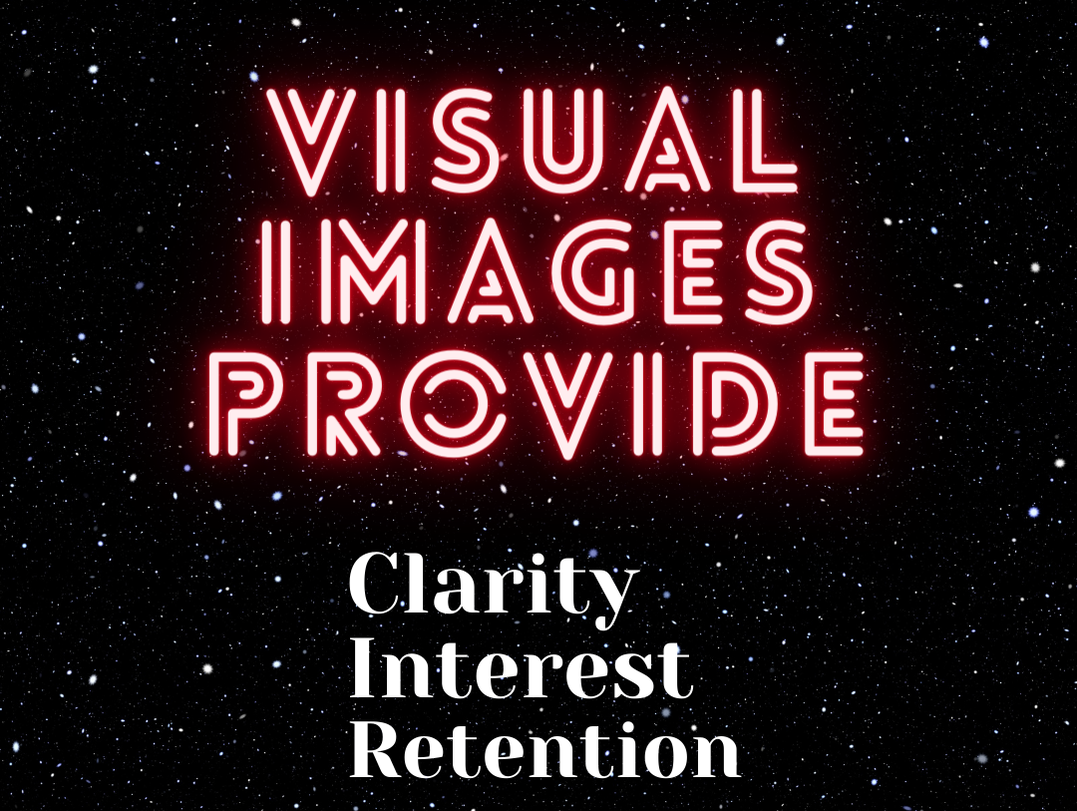|
Studies have found that retention is greater with pictures when compared to the written word. The brain will absorb a picture and store it to memory along with a corresponding word. The written word is stored by the brain as only the written word. If you compare remembering the contents of a book to the camera shots of a two hour movie, the recall is much greater for the video image as opposed to words on a page. Visual aids have the duality of a picture and a word. Learning to use a visual aid appropriately and effectively in a speech will increase the probability of a more memorable experience.
A visual aid accomplishes three objectives: clarity, interest and retention. When a speaker discusses an object and shows it at the same time, it provides clarity. If you’re discussing the recent SpaceX’s Crew Dragon capsule docking at the space station, clarity is amplified with pictures and an explanation. Interest is the second objective achieved by using visual aids. When performing demonstration speeches, it’s important to have a physical demo to keep the audience’ attention as you go through the step-by-step process. While recalling a recent speech by an online student. his topic was 'how to change a tire'. Without a good visual presentation, a speech topic such as this would be like watching paint dry. However, with a little bit of finesse, explaining how to use the car jack or take off the lug nuts is much more interesting with visual aids. The third objective of the visual aid is to provide retention. The amount of information we receive on a daily basis is insane. Being expected to keep up with everything we hear and see is impossible. Our brains go into overdrive and a good chunk of information is lost. By using pictures, our mind ingests information two-fold...by picture and word association. Types of visual aids There are so many different types of visual aids. Today, many use computer- generated presentations. If your plan is to use a PowerPoint, make sure the slides are sharp, simple, and to the point. Deliver your speech extemporaneously. In order to deliver a speech with few notes, a speaker will need to know the content of the slides. A speaker should be able to glance at the screen for a quick review then make eye contact once again with the audience. Other types of visual aids include objects, scaled-down models of objects, photographs, artwork, graphs, maps, or the speaker. It’s a matter of being creative and finding the best possible visual aid for your speech. How to use the visual aid After finding a suitable visual aid, the next step is incorporating it into the speech. . If you’re going to use a visual aid, you need to know how to explain it. To simply show a visual aid without explanation may confuse the audience. Explain why you’re presenting the visual aid and what it means. Remember, the goal is to provide clarity, interest, and retention. At first, it may seem awkward. If you’re demonstrating how to do something or make something, the body of the speech will be the demonstration. If you haven’t practiced using your props, you may make a mess of it all. By practicing with the visual aid, you'll find the places that need to be adjusted. Another pitfall from lack of practice is the ‘dead air’ time during the speech. It’s important to keep the audience engaged. For instance, some students like to demonstrate how to cook or bake something. They’ll bring all their props, maybe even dessert for the classroom to sample. As the mixing process begins, students forget to speak. They forget they have an audience resulting in ‘radio silence’. If you’re going to demonstrate a process, be sure and have a couple of short stories or examples to share with the audience while demonstrating. When creating visual aids, remember to keep them simple. If designing a PowerPoint, use a limited number of fonts. Be sure and use color on the slides to increase retention. Only have the visual aid in front of the audience as you’re explaining it. If you leave it in plain sight the entire presentation, the audience may continue to review the visual as opposed to listening to your speech. If you have handouts, don’t pass them around while giving your speech, wait until after the speech has concluded. If there’s something the audience needs to see while you’re speaking, enlarge the handout or use a projector. It’s smart to use visual aids in your speeches. They aren’t meant to be a crutch, they’re meant to further enhance your delivery.
0 Comments
Leave a Reply. |
Written byLiz Latta, Editor/WKCTC Instructor with over 15 years teaching experience. Master's Degree in Organizational Communications from Murray State University Archives
February 2021
Public Speaking |

 RSS Feed
RSS Feed